Abstract
The quantity of the main pollutants present in the atmosphere (particulate matter, ozone, sulfur dioxide, nitrogen dioxide) and meteorological events (rain) can cause permanent or catastrophic damage to plant growth. This study was conducted for the environmental assessment of the Italian territory, in the cities of Palermo, Bari, Ferrara, Padua, and Venice, which respectively represent southern, central, and northern Italy, in order to have a territory global environmental view. The aim of this research is to analyze the relationship between air pollution (PM10, O3, NO2, SO2) and crops (durum and common wheat, corn) as a basis for the subsequent definition of an agronomic model. Later, meteorological events were also added to the analysis, to have a complete overview for the evaluation, since meteorological events contribute to the pollutants’ behavior and favor the deposition of the latter on the vegetation, increasing the negative and toxic effect on crops. The analyses showed that pollutants have a significant effect on crops and in particular ozone appears to be the most influential parameter.
1. Introduction
Air quality and in general the effect of pollutants on various matrices is among the topics most frequently addressed by scientific research. The harmful effect of pollutants on the human body is extensively documented and widely acknowledged, with numerous studies linking it to respiratory diseases, cardiovascular conditions, and premature mortality [1,2]. This consensus is backed by a substantial body of evidence highlighting how pollutants such as particulate matter, nitrogen oxides, and sulfur dioxide adversely affect human well-being. On the other side, the effects of air pollution on agriculture are still being actively explored. Researchers across the globe are conducting various studies to understand how pollutants impact crop yield, soil health, and overall agricultural productivity [3,4]. These investigations are crucial for developing strategies to mitigate the negative effects of air pollution on food security and agricultural sustainability, as the exact mechanisms and extent of the damage are not yet fully understood. Although the agricultural sector contributes considerably to pollution with the formation of particulate matter due to the burning of biomass residues [5] and represents about 96% of national NH3 emissions [6], it is among the sectors most affected by climate change and the effects of pollution of the planet’s limited resources (air, water, and soil). Dependence on the climate has led to innumerable negative impacts on the agricultural system and on food security and the agri-food chain. Knowledge of the pollutants’ impact and other factors, such as meteorology, on crop growth is of fundamental importance for correct crop management to maximize agricultural yield [7]. The pollutants’ impact such as ozone on cereal crops (wheat, rice, soy, and corn) and on fruit and vegetable crops (grapes) has highlighted their influence on the decrease in the wheat and rice production [8] and a reduction in vine growth [9]. High levels of pollutants like NO2 and O3 can modify the fruits’ growth, like navel oranges [10] and tomatoes [11], influencing their organoleptic characteristics and flavor.
Air pollution can affect food quality and subsequently impact human health, as airborne contaminants can settle on crops and contaminate soil and water used in food production. These pollutants may accumulate in food items, reducing their nutritional value and introducing harmful substances into our bodies, potentially leading to respiratory issues, cardiovascular diseases, and other health problems [12].
The particulate matter reaches the vegetation through sedimentation, by dry and wet deposition, and particularly PM2.5 (particulate matter with an equivalent diameter of less than 2.5 μm) has a significant negative effect on wheat production [13]. Nitrogen dioxide (NO2) is one of the most phytotoxic greenhouse gases because its high-water solubility favors its absorption by the plants’ roots, while sulfur dioxide (SO2) absorption occurs via the stoma causing tissue paralysis with swelling of chloroplasts and carbon monoxide (CO) causes a decrease in the photosynthesis rate. The synergy between gaseous (NO2, SO2, CO) and solid (PM10) pollutants can lead to a reduction in plant growth, photosynthesis, and therefore a decrease in agricultural production [14].
On the other hand, plants play a crucial role in reducing pollution through several mechanisms. They absorb carbon dioxide (CO2) during photosynthesis, helping to mitigate the effects of climate change by lowering atmospheric CO2 levels. Additionally, plants can filter pollutants from the air, such as particulate matter, sulfur dioxide, and nitrogen oxides, by trapping these substances on their leaves and surfaces. In fact, some specific species are used in urban forestry to increase environmental benefits and mitigate the effects of climate change [15]. Moreover, in their 2023 study, Gong et al. highlight the crucial role of urban vegetation in air phytoremediation, emphasizing the gap between scientific research and environmental management perspectives [16].
Rain has a strong influence on the aero-dispersed pollutants and on plant growth. With rains, plants activate a series of chemical processes to prevent water from causing damage to the leaves or the plant surface. With an excessive amount of water, vegetation undergoes a process known as radical asphyxia, that is, it is unable to correctly exchange gases with the atmosphere and absorb all the necessary nutrients it needs to live. For this reason, it is necessary to include information relating to rain and any relevant meteorological events in the analyses of the pollutants’ effects [17].
Information on pollutant levels can be obtained by strategically implementing air quality monitoring networks next to agricultural sites [18]. They allow the reliable measurement of airborne pollutants with different IoT-based technologies [19,20,21], and the information obtained from the pollutants’ measurement can be used for the forecasting space-time models definition and the analysis of accidental events [22,23,24]. Technologically advanced air quality monitoring systems also integrate instruments for meteorological parameters measurements such as temperature, pressure, relative humidity, rainfall, and wind direction and intensity, which are fundamental both for analyzing the effects on crops and for the definition of emission sources research models [25].
The diffusion of new technologies has led the agri-food sector—which constitutes an increasingly important part of the Italian economy—to important transformations. These technologies such as the internet of things (IoT) and artificial intelligence (AI) can make a difference and contribute to a further evolution of this sector, driving it towards Agriculture 4.0 and 5.0 solutions for mapping and remote monitoring of crops or agricultural machinery, and for business management [22]. Research in the agricultural sector has focused in recent years on researching the influence of pollutants on crops. However, the pollutants considered are related to the use of pesticides, fertilizers [23], and emissions relating to the combustion of agricultural residues [24], but studies using measured air quality data are lacking.
The aim of the work is therefore to verify if there are significant effects of pollutants on the growth of cereal crops in some Italian cities which represent the national territory. The data relating to the pollutant levels were obtained from measurement systems installed on the territory. This work reports the analysis carried out according to the crop cycle. In detail, for durum and common wheat, it has been referred to the October/June period while for corn to the April/November period. In fact, in the months considered, the sowing, growth, and consequent harvesting of the considered cereals takes place.
Subsequently, the influence of rain was considered, using monthly rainfall data to verify the effect on crops in the periods considered. Similar consideration was made regarding the analysis of pollutants; therefore, the concentration values used for the ANOVA analysis are reported as the averages calculated for the growth periods considered for the crops.
2. Materials and Methods
2.1. Air Quality Data
The air quality analysis was conducted using data from the air quality database provided by the European Environmental Agency (EEA) [25] and the Institute for Environmental Protections’ BRACE dataset [26]. The analysis was conducted on different representative cities of northern, central, and southern Italy: Palermo, Bari, Ferrara, Padua, and Venice, in the period 2012–2021.
The available data allowed the average annual concentrations of PM10, O3, SO2, and NO2 to correlate these data with the agricultural production values aggregated at an annual level (Table 1, Table 2 and Table 3).

Table 1.
Annual average concentrations measured in Palermo and Bari in the period 2012–2021.

Table 2.
Annual average concentrations measured in Ferrara in the period 2012–2021.

Table 3.
Annual average concentrations measured in Padua and Venice in the period 2012–2021.
2.2. Crops Data
The cultivation analysis was conducted on various crops such as durum wheat, common wheat, and corn using data from the Italian National Statistical Institute (ISTAT) database [27]. As for the air quality, the analysis was conducted in Palermo, Bari, Ferrara, Padua, and Venice during the period 2012 to 2021.
The database took into account the quantity of crops produced per hectare and then calculated the yield per hectare to determine the actual amount of production (Table 4, Table 5, Table 6 and Table 7).

Table 4.
Agricultural production of durum wheat in Palermo and Bari in the period 2012–2021.

Table 5.
Agricultural production of common wheat in Ferrara in the period 2012–2021.

Table 6.
Agricultural production of durum wheat in Padua in the period 2012–2021.

Table 7.
Agricultural production of corn in Padua and Venice in the period 2012–2021.
2.3. Meteorological Data
Meteorological data for Palermo, Bari, Ferrara, Padua, and Venice during a period running from 2012 to 2021 were used to analyze the effect of weather on the crops.
Rainfall data from an online database of the Italian weather station were considered [25]. The site took into consideration the monthly in rain millimeters, then an average was made for all the years considered to determine the effect on crops according to the crop’s life cycle—April/November for corn and October/June for wheat (Table 8 and Table 9).

Table 8.
Millimeters of rain measured in the considered Italian cities in the period October–June 2012–2021.

Table 9.
Millimeters of rain measured in the considered Italian cities in the period April–November 2012–2022.
2.4. Analysis
For the data fitting (pollutant concentration, millimeters of rain, and annual crop production considered in the crop life cycle period), a linear regression model was used in the first analysis. Using the relationship found, the effective crops production affected by the pollutants was calculated. The linear regression model showed very weak values of the Pearson coefficient, calculated for each pollutant, indicating poor data linearity.
Therefore, a quadratic regression of the type was used to fit the data which gave the best results. The coefficients of the quadratic curve are reported in Table 10. Since the R2 values are in some cases very low, they are better than the linear ones found in the first analysis.

Table 10.
Quadratic correlation coefficients.
For subsequent analysis of significance between crops and air quality, a one-way analysis of variance (ANOVA) was performed.
The ANOVA was necessary to verify if any variations or different levels of the independent variable (concentration of pollutants and millimeters of rain) affect the dependent variable (production) through a measurable effect and if at least one pair of means has significant differences.
The null hypothesis () that the means of three or more components (in this case five) would be equal is compared with the alternative hypothesis () that at least one mean would be different. The variables considered are five and the hypotheses are the following:
In this scenario, the hypotheses consider five distinct datasets related to five environmental components: PM10, O2, NO2, SO2, and rain. The objective is to determine whether there is a significant difference among the means of these datasets. The null hypothesis () means that there are no significant differences between the means of these datasets while the alternative hypothesis () allows that at least one of the five datasets’ means is different from the others. This implies that there might be a significant variation in the average levels of one or more components compared to the others. Accepting the null hypothesis would mean concluding that the average conditions observed for the five components are essentially similar, and any observed differences could be due to chance or natural statistical variability. On the other side, accepting the null hypothesis could indicate that one of the environmental components behaves differently on average, possibly due to specific environmental factors, local emissions, climate variations, or other phenomena that affect that component more strongly.
Data used in the ANOVA analysis were obtained as the absolute value of the difference between the measured and the estimated production using the quadratic relationship previously found. Fisher values between the 99% and 95% level of significance were used for statistical testing of cultures.
Based on the analyses carried out, the ANOVA rejects the hypothesis , indicating that the chosen variables (pollutants and rain) affect the crops, except for the analysis made for the city of Palermo, which accepts the hypothesis , indicating that none of the variables taken into consideration affect the dependent variable (crop production). Having defined the statistical test of the ANOVA, it can be noted that among the dependent variables one has values that are high, in particular ozone. This indicates that the ozone is the variable that most affects the production. The corn production in Padua changes the incidence of variables on production according to the degree of importance. Using a 95% significance level will reject the hypothesis while using a 99% significance level will accept the hypothesis.
3. Results
3.1. Air Quality
Yearly data of air quality were compared considering the pollutants’ legal limits defined by the D.Lgs. 155/2010, which are the following:
- Particulate matter: annual limit of 40 µg/m3;
- Ozone: annual limit of 100 µg/m3;
- Nitrogen dioxide: annual limit of 200 µg/m3;
- Sulfur dioxide: annual limit of 40 µg/m3.
The interquartile range (IQR), calculated as the difference between the 75th and the 25th, has been evaluated as a measure of statistical dispersion of the data. To compare values among variables, Table 11 reports IQR values normalized with respect to the mean value of each pollutant in each site.

In analyzing the variability according to the normalized IQR of the different sites, it becomes evident that Palermo exhibits the highest degree of variability, while Ferrara and Venice record the lowest values. Nevertheless, the IQR absolute values are low.
In Palermo, no pollutant exceeds the set annual limit. The particulate matter concentration was constant during 2013–2019 and then decreased in 2020, when a minimum was recorded (probably due to the COVID-19 pandemic situation), and emissions increased again in 2021. The minimum for ozone concentration appears to be in 2019, but in subsequent years the concentration will return to or approach the level of 2015. Sulfur dioxide concentrations are very low and appear to be constant, except in 2020, when it reaches its weak peak (Figure 1).
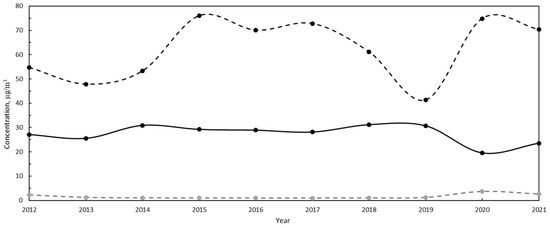
Figure 1.
Annual particulate matter (black solid line), ozone (black dashed line), and sulfur dioxide (grey dashed line) concentrations measured in Palermo during 2012–2021. Sulfur dioxide is reported on the secondary axis.
In Bari no pollutant exceeds the set annual limit. The PM10 concentration appears to constant with a slight decrease from 2017. The ozone concentration does not have a linear trend because it seems to have a decreasing and increasing trend depending on the year. The concentration of nitrogen dioxide, on the other hand, has a linear decline from 2017 (Figure 2).
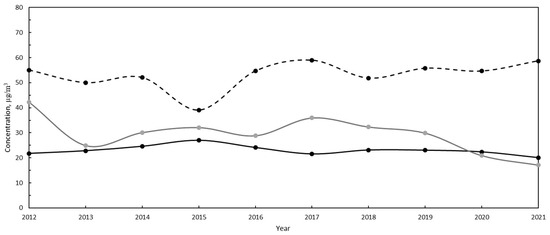
Figure 2.
Annual particulate matter (black solid line), ozone (black dashed line), and nitrogen dioxide (grey solid line) concentrations measured in Bari during 2012–2021.
The city of Ferrara has no pollutants exceeding the established annual limits. Particulate matter concentrations are constant, except for a small peak in 2012 and 2020. Ozone concentration appears to have constant values in the considered period. Nitrogen dioxide concentrations are decreasing from 2013 except in 2019, when the largest peak occurs (Figure 3).
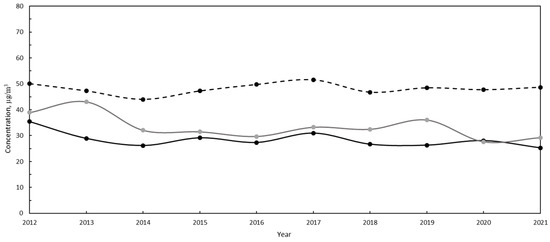
Figure 3.
Annual particulate matter (black solid line), ozone (black dashed line), and nitrogen dioxide (grey solid line) concentrations measured in Ferrara during 2012–2021.
The city of Padua has no pollutants exceeding the established annual limits. The particle concentration appears to decrease in 2012–2014 and in 2019–2021. The ozone concentration decreases in the first two years considered (from 2012 to 2014), remaining constant until 2020 when a linear increase seems to apply. The nitrogen dioxide concentration decreases linearly from 2017, and the sulfur dioxide concentration remains constant for all the years considered (Figure 4).
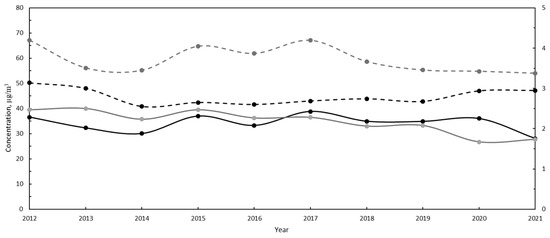
Figure 4.
Annual particulate matter (black solid line), ozone (black dashed line), nitrogen dioxide (grey solid line), and sulfur dioxide (grey dashed line) concentrations measured in Padua during 2012–2021. Sulfur dioxide is reported on the secondary axis.
In Venice, no pollutant exceeds the set annual limit. and particle concentrations decrease linearly over the years 2012–2014 with a slight increase that varies until 2021. Ozone concentrations reach a low peak in 2016 and 2019 but remain constant thereafter. The concentration of nitrogen dioxide reaches a minimum in 2020, but the curve tends downwards. Sulfur dioxide remains constant for all the years considered (Figure 5).
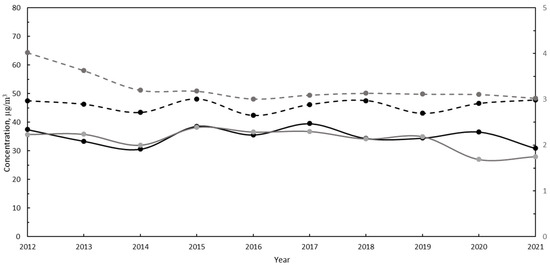
Figure 5.
Annual particulate matter (black solid line), ozone (black dashed line), nitrogen dioxide (grey solid line), and sulfur dioxide (grey dashed line) concentrations measured in Venice during 2012–2021. Sulfur dioxide is reported on the secondary axis.
3.2. Crops Analysis
Crop yield production values are reported in the following figures (Figure 6, Figure 7 and Figure 8) to analyze the production behavior during the years considered.
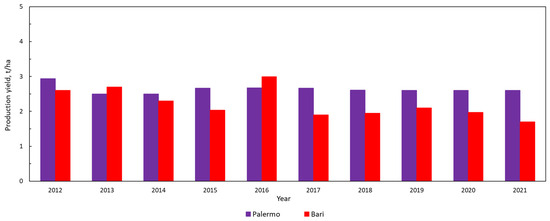
Figure 6.
Yield production of durum wheat in Palermo and Bari during the period 2012–2021.

Figure 7.
Yield production of common wheat in Ferrara and Padua during the period 2012–2021.
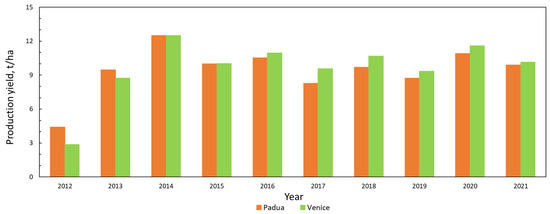
Figure 8.
Yield production of corn in Padua and Venice during the period 2012–2021.
The durum wheat production in Palermo has remained almost constant in the years considered (2012–2021), while in Bari, there is a decrease between 2012 and 2015 and a peak in 2016 which, however, already shows a decline from the following year which remains constant until 2021. Crop yields appear to be higher in Palermo, as this ratio translates into a higher production of durum wheat per hectare of land in Palermo than in Bari, even though the hectares of land in Bari increased from 2017 to 2021. It is only in 2016 that the crop yields in Bari are higher than those in Palermo (Figure 6).
The production of common wheat in Padua increased in the years 2013–2016 with a slight decrease until 2019. In 2020–2021, the production in Padua increases again. The city of Ferrara has had an increase in hectares which has led to a linear increase in production. Instead, the city of Padua had an increase in cultivated hectares in 2018, before recording a low in 2019 and a drop in production. Over the years, the production in the city of Ferrara has been high except for 2012–2014 when the crop yields are comparable (Figure 7).
Corn production in Padua and Venice appears to be similar over the years. The crops of both cities had an increase from 2012 to 2014 and were almost constant over the years (Figure 8). Padua and Venice are close, so the production is similar.
3.3. Meteorological Analysis
The satellite recorded a decrease in annual rainfall but an increased concentration of millimeter-scale rainfall. Although the cities of Venice, Padua, and Ferrara had very similar rainfall levels in 2017–2018, the city of Padua has recorded a significant increase in rainfall since 2019. From Figure 9 it is possible to see the maximum peak in 2021 in Palermo. Bari has kept the millimeters of rain constant over the years, having only a small increase between the years 2017 and 2018. The city of Palermo recorded an almost constant trend until 2020 with a maximum in 2021, showing a difference of about 1000 units compared to the previous year. Padua and Venice have similar values since they are very close, but Venice seems to record a higher mm of rainfall (Figure 9 and Figure 10).
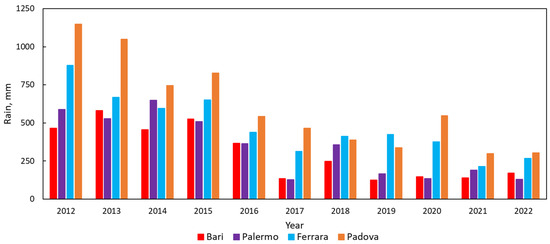
Figure 9.
Millimeters of rain recorded in the Italian cities in the life cycle period for wheat—October/June from 2012 to 2021.
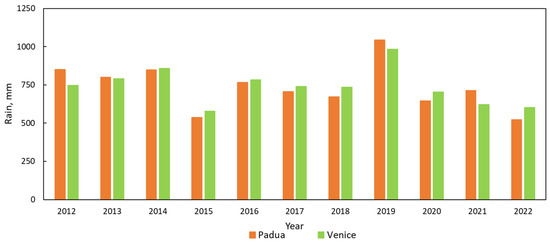
Figure 10.
Millimeters of rain recorded in the Italian cities in the life cycle period for corn—April/November from 2012 to 2021.
3.4. Ozone Effect on Crops
ANOVA results have shown that the factor that has a significant effect on the plant growth of durum wheat, common wheat, and corn is ozone. In fact, for all the crops considered, the ANOVA analysis rejected the hypothesis , accepting the hypothesis for which there is a significant influence of the factors. Among the variables considered, the most influential appears to be ozone since it seems to have a more marked difference between the averages of the populations than the others.
In Figure 11, Palermo appears to be the only city not to be affected by the presence of pollutants. This can be seen from the minimum levels that ozone reached in 2019, which did not affect the production of durum wheat, which remained constant during all the years considered in the study, 2012–2021 (Figure 11). Statistical tests show that the durum wheat production in Bari is affected by the presence of polluting substances present in the atmosphere, especially ozone. In fact, a small decrease in crop production can be seen as the concentration of the pollutant increases. This is demonstrated in the last two years considered in the study, 2020–2021. But, considering all the values over the years, the trend remains constant over time (Figure 2).
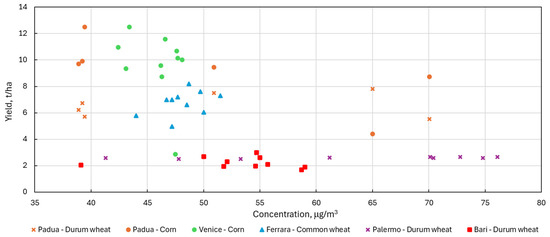
Figure 11.
Production yield (t/ha) and ozone concentration in the Italian sites for corn, durum wheat, and common wheat.
The production of common wheat in Ferrara is greatly influenced by the concentrations of ozone in the atmosphere. There is a maximum annual production of 279,792 tons (yield of 8.2) of durum wheat up to an ozone concentration of 48.7 µg/m3. For ozone concentrations greater than 47 µg/m3 there are common wheat production values that reach a maximum of about 280,000 tons, as in the case of the city of Padua.
The study for the corn production in Padua and Venice obtains a very variable ozone concentration. At ozone concentrations between 35 and 50 µg/m3 there is a production of between 290,000 and 305,000 tons of corn per year (yield of about 8 and 13); at ozone concentrations between 65 and 70 µg/m3 the production yield decreases from 8.7 to 4.4, and the annual production of corn is between 277,000 and 302,000 tons for both cities considered.
4. Discussion
The results of the study highlight the complex interplay between air quality, meteorological conditions, and crop yields across various Italian cities over the period considered. The findings suggest that while pollutant levels generally remained within legal limits across all locations, the variations in specific pollutants, particularly ozone, had noticeable impacts on crop production.
The air quality data revealed that none of the monitored cities exceeded the annual legal limits for PM10, NO2, O3, or SO2 during the study period. Particularly noteworthy is the case of ozone, which, despite staying within the prescribed limits, emerged as the most influential factor affecting crop yields. The results align with previous research by Van Dingenen et al. [8], which underscores ozone’s detrimental effects on plant health. The fact that ozone levels had a measurable impact on crop production, even without exceeding the legal thresholds, suggests that current regulatory limits may not fully account for the sensitivity of agricultural systems to this pollutant.
The analysis of the ANOVA results showed that all the variables considered (NO2, SO2, PM10, O3, and rain) have a significant influence on the yield linked to agricultural production. The analysis of crop yields across the cities showed distinct trends tied to the environmental and air quality data. In Palermo, durum wheat production remained stable despite fluctuating ozone levels, indicating a possible resilience in this specific context. In contrast, Bari’s durum wheat production exhibited a slight decline in response to increasing ozone concentrations, particularly during the last two years of the study. This suggests that while the overall trends in Bari remained stable, the presence of ozone had a subtle yet significant impact on crop productivity.
For common wheat, the results from Ferrara and Padua further underscore the influence of ozone. Ferrara demonstrated high sensitivity to ozone concentrations, with yield peaks closely tied to specific ozone levels. This indicates that common wheat is particularly vulnerable to changes in air quality, especially ozone, which can cause substantial fluctuations in yield.
Similarly, corn production in Padua and Venice showed a clear correlation with ozone levels. As ozone concentrations increased, crop yields decreased, with significant drops observed at higher ozone levels. This pattern highlights the importance of monitoring and managing ozone levels, even within the currently accepted limits, to safeguard crop productivity. Furthermore, in the case of corn production in Venice, in addition to ozone, SO2 also appears to be influential. This pollutant is characteristic of emissions linked to the port area and linked to the use of naval fuels which contain a high sulfur content.
In this preliminary analysis only, rain was considered as a meteorological factor, and the meteorological analysis revealed a general decline in annual rainfall across most cities, accompanied by an increase in heavy rain events. While rainfall is typically beneficial for crop growth, the variability in precipitation patterns can pose challenges. For instance, excessive rainfall, as observed in Padua from 2019 onwards, can lead to adverse effects on crop health and yield.
The case of Palermo is particularly interesting, as it recorded a sharp increase in rainfall in 2021, which did not seem to negatively affect crop yields, suggesting that the region’s crops may be more adaptable to such fluctuations. However, the overall trend of declining rainfall combined with sporadic heavy rain events could pose long-term risks to agricultural stability in these regions.
The influence of the COVID-19 pandemic in 2020 must be considered, as it led to drastic changes in pollutant levels due to the resulting lockdowns. While the pandemic caused a reduction in pollutant concentrations in many parts of the world [28], the situation in Italy was more complex and varied [25,26], as shown in Figure 1, Figure 2, Figure 3, Figure 4 and Figure 5. ANOVA analysis revealed that all variables considered (NO2, SO2, PM10, O3, and rainfall) significantly affect agricultural yield.
This work confirms that ozone influences the growth of cereal crops [29] and analyzes the Italian case. The studies carried out on the Italian territory mainly analyze the effect of the use of nitrate-based pesticides on crops [30,31,32] and do not consider the quality of the ambient air with which the crops come into contact.
The definition of the most influential factors on growth mechanisms is important for the subsequent definition of an agronomic model to support production.
5. Conclusions
The purpose of this study is to analyze the effect of pollutants and weather on crops to develop a future agronomic model. The analysis was carried out specifically considering different representative cities of northern, central, and southern Italy: Palermo, Bari, Ferrara, Padua, and Venice, in order to have an overview of the whole nation.
Using a quadratic regression, it was possible to fit the data well for the development of the one-way variance analysis (ANOVA). The research shows that all crop production is influenced by the presence of pollutants in the atmosphere and by the millimeters of rain, except for the production of durum wheat in Bari, for which the statistical test is always negative. This indicates that no type of variable used influences plant growth and, therefore, the production of durum wheat in the city of Bari.
For Venice, where there is the production of corn crops, in addition to ozone, sulfur dioxide also seems to influence the development of vegetable growth, but it will be discussed in the future work.
The study’s results emphasize the need to include air quality analysis for agricultural management. While pollutant levels in these Italian cities remain within legal limits, the significant impact of ozone on crop yields indicates that these thresholds might need reconsideration, particularly in agricultural areas. Additionally, the variability in meteorological conditions, especially rainfall, further complicates the relationship between air quality and crop production. These findings suggest that future policies should consider not just the average levels of pollutants but also their variability and interactions with local climate conditions to better protect agricultural productivity.
Author Contributions
Conceptualization, N.L., D.S. and C.L.; methodology, N.L. and D.S.; software, N.L. and C.L.; validation, N.L. and D.S.; formal analysis, N.L.; investigation, D.S.; data curation, N.L. and C.L.; writing—original draft preparation, N.L.; writing—review and editing, N.L., D.S. and C.L.; visualization, D.S.; supervision, D.S.; project administration, D.S. All authors have read and agreed to the published version of the manuscript.
Funding
This research received no external funding.
Institutional Review Board Statement
Not applicable.
Informed Consent Statement
Not applicable.
Data Availability Statement
Data are available at https://discomap.eea.europa.eu/map/fme/AirQualityExport.htm (accessed on 12 January 2024); https://www.ismeamercati.it/flex/cm/pages/ServeBLOB.php/L/IT/IDPagina/2208 (accessed on 12 January 2024); and https://www.3bmeteo.com/ (accessed on 12 January 2024).
Acknowledgments
The authors are thankful to Elisabetta Pia Graziano for her helpful work.
Conflicts of Interest
Authors Carmine Laudato and Daniele Sofia were employed by the company Sense Square Srl. The remaining author declares that the research was conducted in the absence of any commercial or financial relationships that could be construed as a potential conflict of interest.
References
- Lotrecchiano, N.; Montano, L.; Bonapace, I.M.; Giancarlo, T.; Trucillo, P.; Sofia, D. Comparison Process of Blood Heavy Metals Absorption Linked to Measured Air Quality Data in Areas with High and Low Environmental Impact. Processes 2022, 10, 1409. [Google Scholar] [CrossRef]
- Olutola, B.G.; Mwase, N.S.; Shirinde, J.; Wichmann, J. Apparent Temperature Modifies the Effects of Air Pollution on Cardiovascular Disease Mortality in Cape Town, South Africa. Climate 2023, 11, 30. [Google Scholar] [CrossRef]
- Pandya, S.; Gadekallu, T.R.; Maddikunta, P.K.R.; Sharma, R. A Study of the Impacts of Air Pollution on the Agricultural Community and Yield Crops (Indian Context). Sustainability 2022, 14, 13098. [Google Scholar] [CrossRef]
- Wei, W.; Wang, Z. Impact of Industrial Air Pollution on Agricultural Production. Atmosphere 2021, 12, 639. [Google Scholar] [CrossRef]
- Junpen, A.; Roemmontri, J.; Boonman, A.; Cheewaphongphan, P.; Thao, P.T.B.; Garivait, S. Spatial and Temporal Distribution of Biomass Open Burning Emissions in the Greater Mekong Subregion. Climate 2020, 8, 90. [Google Scholar] [CrossRef]
- Istituto Superiore per la Protezione Ambientale, ISPRA. Annuario Dei Dati Ambientali, ISPRA, Roma, 69/2016. 2016. Available online: https://www.isprambiente.gov.it/it/pubblicazioni/stato-dellambiente/annuario-dei-dati-ambientali-edizione-2016 (accessed on 8 February 2024).
- Almady, S.S.; Al-Sager, S.M.; Al-Janobi, A.A.; Marey, S.A.; Aboukarima, A.M. Evaluation of Air Pollution Levels in Agricultural Settings Using Integrated Weather Variables and Air Pollutants. Appl. Sci. 2024, 14, 5713. [Google Scholar] [CrossRef]
- Van Dingenen, R.; Dentener, F.J.; Raes, F.; Krol, M.C.; Emberson, L.; Cofala, J. The global impact of ozone on agricultural crop yields under current and future air quality legislation. Atmos. Environ. 2009, 43, 604–618. [Google Scholar] [CrossRef]
- Fumagalli, I.; Cieslik, S.; De Marco, A.; Proietti, C.; Paoletti, E. Grapevine and Ozone: Uptake and Effects. Climate 2019, 7, 140. [Google Scholar] [CrossRef]
- El-Khayat, H.M.; Zaki, G.R. Air Pollution Effects on Vegetative Growth, Fruit Quality and Mineral Composition of Washington Navel Orange. Int. J. Environ. 2020, 9, 1–13. [Google Scholar] [CrossRef]
- Anderson, L.S.; Mansfield, T.A. The effects of nitric oxide pollution on the growth of tomato. Environ. Pollut. 1979, 20, 113–121. [Google Scholar] [CrossRef]
- Guo, W.; Pan, B.; Sakkiah, S.; Yavas, G.; Ge, W.; Zou, W.; Tong, W.; Hong, H. Persistent Organic Pollutants in Food: Contamination Sources, Health Effects and Detection Methods. Int. J. Environ. Res. Public Health 2019, 16, 4361. [Google Scholar] [CrossRef] [PubMed]
- Zhou, L.; Chen, X.; Tian, X. The impact of fine particulate matter (PM2.5) on China’s agricultural production from 2001 to 2010. J. Clean. Prod. 2018, 178, 133–141. [Google Scholar] [CrossRef]
- Adrees, M.; Ibrahim, M.; Shah, A.M.; Abbas, F.; Saleem, F.; Rizwan, M.; Hina, S.; Jabeen, F.; Ali, S. Gaseous pollutants from brick kiln industry decreased the growth, photosynthesis, and yield of wheat (Triticum aestivum L. ). Environ. Monit. Assess. 2016, 188, 267. [Google Scholar] [CrossRef] [PubMed]
- Kacprzak, M.J.; Ellis, A.; Fijałkowski, K.; Kupich, I.; Gryszpanowicz, P.; Greenfield, E.; Nowak, D. Urban forest species selection for improvement of ecological benefits in Polish cities—The actual and forecast potential. J. Environ. Manag. 2024, 366, 121732. [Google Scholar] [CrossRef] [PubMed]
- Gong, C.; Xian, C.; Wu, T.; Liu, J.; Ouyang, Z. Role of urban vegetation in air phytoremediation: Differences between scientific research and environmental management perspectives. npj Urban Sustain. 2023, 3, 24. [Google Scholar] [CrossRef]
- Damtew, A.; Teferi, E.; Ongoma, V.; Mumo, R.; Esayas, B. Spatiotemporal Changes in Mean and Extreme Climate: Farmers’ Perception and Its Agricultural Implications in Awash River Basin, Ethiopia. Climate 2022, 10, 89. [Google Scholar] [CrossRef]
- Sofia, D.; Lotrecchiano, N.; Giuliano, A.; Barletta, D.; Poletto, M. Optimization of number and location of sampling points of an air quality monitoring network in an urban contest. Chem. Eng. Trans. 2019, 74, 277–282. [Google Scholar] [CrossRef]
- Lotrecchiano, N.; Sofia, D.; Giuliano, A.; Barletta, D.; Poletto, M. Real-time on-road monitoring network of air quality. Chem. Eng. Trans. 2019, 74, 241–246. [Google Scholar] [CrossRef]
- Sofia, D.; Lotrecchiano, N.; Trucillo, P.; Giuliano, A.; Terrone, L. Novel air pollution measurement system based on ethereum blockchain. J. Sens. Actuator Netw. 2020, 9, 49. [Google Scholar] [CrossRef]
- Sofia, D.; Giuliano, A.; Gioiella, F.; Barletta, D.; Poletto, M. Modeling of an air quality monitoring network with high space-time resolution. In Computer Aided Chemical Engineering; Friedl, A., Klemeš, J.J., Radl, S., Varbanov, P.S., Wallek, T., Eds.; Elsevier: Amsterdam, The Netherlands, 2018; Volume 43, pp. 193–198. [Google Scholar] [CrossRef]
- Martos, V.; Ahmad, A.; Cartujo, P.; Ordoñez, J. Ensuring Agricultural Sustainability through Remote Sensing in the Era of Agriculture 5.0. Appl. Sci. 2021, 11, 5911. [Google Scholar] [CrossRef]
- Tian, S.; Xu, Y.; Wang, Q.; Zhang, Y.; Yuan, X.; Ma, Q.; Feng, X.; Ma, H.; Liu, J.; Liu, C.; et al. The effect of optimizing chemical fertilizers consumption structure to promote environmental protection, crop yield and reduce greenhouse gases emission in China. Sci. Total Environ. 2023, 857, 159349. [Google Scholar] [CrossRef] [PubMed]
- Sahu, S.K.; Mangaraj, P.; Beig, G.; Samal, A.; Pradhan, C.; Dash, S.; Tyagi, B. Quantifying the high resolution seasonal emission of air pollutants from crop residue burning in India. Environ. Pollut. 2021, 286, 117165. [Google Scholar] [CrossRef] [PubMed]
- European Environmental Agency, EEA. Air Quality Data. Available online: https://discomap.eea.europa.eu/map/fme/AirQualityExport.htm (accessed on 15 February 2024).
- BRACE Dataset. Available online: https://osservatorio.sina.isprambiente.it/dataset/archivio-storico-dei-dati-di-qualit-dellaria-dal-2002-al-2012-brace (accessed on 1 February 2024).
- National Statistical Institute (ISTAT). Cereali-Produzione, Superfici e Rese. Available online: https://esploradati.istat.it/databrowser/#/it/dw (accessed on 24 February 2024).
- Maghrebi, M.; Danandeh Mehr, A.; Karrabi, S.M.; Sadegh, M.; Partani, S.; Ghiasi, B.; Nourani, V. Spatiotemporal Variations of Air Pollution during the COVID-19 Pandemic across Tehran, Iran: Commonalities with and Differences from Global Trends. Sustainability 2022, 14, 16313. [Google Scholar] [CrossRef]
- Schiferl, L.D.; Heald, C.L. Particulate matter air pollution may offset ozone damage to global crop production. Atmos. Chem. Phys. 2018, 18, 5953–5966. [Google Scholar] [CrossRef]
- Ghiglieri, G.; Barbieri, G.; Vernier, A.; Carletti, A.; Demurtas, N.; Pinna, R.; Pittalis, D. Potential risks of nitrate pollution in aquifers from agricultural practices in the Nurra region, northwestern Sardinia, Italy. J. Hydrol. 2009, 379, 339–350. [Google Scholar] [CrossRef]
- Fagnano, M.; Adamo, P.; Zampella, M.; Fiorentino, N. Environmental and agronomic impact of fertilization with composted organic fraction from municipal solid waste: A case study in the region of Naples, Italy. Agric. Ecosyst. Environ. 2011, 141, 100–107. [Google Scholar] [CrossRef]
- Nguyen, T.P.L.; Seddaiu, G.; Roggero, P.P. Hybrid knowledge for understanding complex agri-environmental issues: Nitrate pollution in Italy. Int. J. Agric. Sustain. 2013, 12, 164–182. [Google Scholar] [CrossRef]
Disclaimer/Publisher’s Note: The statements, opinions and data contained in all publications are solely those of the individual author(s) and contributor(s) and not of MDPI and/or the editor(s). MDPI and/or the editor(s) disclaim responsibility for any injury to people or property resulting from any ideas, methods, instructions or products referred to in the content. |
© 2024 by the authors. Licensee MDPI, Basel, Switzerland. This article is an open access article distributed under the terms and conditions of the Creative Commons Attribution (CC BY) license (https://creativecommons.org/licenses/by/4.0/).